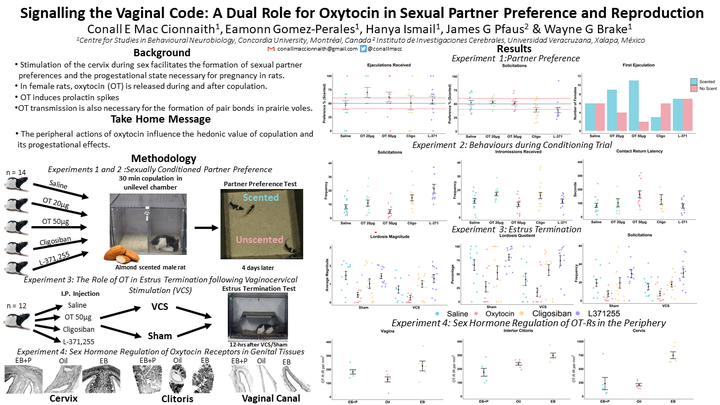Signalling the Vaginal Code. A Dual Role for Oxytocin in Sexual Partner Preference and Reproduction

Conall E. Mac Cionnaith, Eamonn Gomez-Perales, Hanya Ismail, James G. Pfaus, Wayne G. Brake
Presented at the International Society for the Study of Women’s Sexual Health Virtual Meeting 2021
Accepted abstract Introduction: In female rats, paced copulation induces a neuroendocrine response that is necessary for pregnancy. Paced copulation is also a strong sexual reinforcer that results in both conditioned place preference and conditioned sexual partner preference. Although the neuropeptide oxytocin (OT) controls partner preference formation in female prairie voles, it is not known whether OT regulates sexual preference formation in female rats.
Objectives: The current experiments tested whether (i) OT is necessary and sufficient to induce a sexual partner preference, and (ii) OT signalling affects the reproductive effects of pacing that are necessary for both pregnancy and partner preference. These experiments also tested whether peripheral or central OT signalling regulates these behaviours by using an antagonist that enters the CNS (Cligosiban, 5mg/kg; CLG) and one that does not (L-371,257, 1mg/kg; data collection in progress).
Methods: In the first experiment, Long-Evans female rats (n = 14) were injected I.P. with either saline, 20µg OT, 50µg OT, CLG, L-371,257, one minute before their first 30-min sexual experience with a male rat scented with almond. Four days later, the females were given a drug-free 30-min partner preference test in an open field with two males, one scented and the other unscented. The second experiment tested whether OT signalling augments the facilitation of estrous termination that is reliably induced with stimulation of the cervix (VCS). Long-Evans females (n = 12) were injected with either saline, 50µg OT, CLG, or L371,257, 1min prior to sham stimulation or 50 distributed VCSs administered with a lubricated glass rod. Twelve hr after VCS or sham females copulated with a male to assess sexual receptivity.
Results: In the first experiment, females treated with both doses of OT received the scented male’s ejaculation first and more often, but they did not solicit the scented male more often than the unscented male. CLG-treated females received the unscented male’s first ejaculation preferentially and solicited the unscented male more often. In the second experiment, females treated with OT showed decreased sexual receptivity regardless of the type of stimulation, suggesting that OT mimicked the effect of VCS. In contrast, estrous termination was attenuated in females given CLG and L371,257 with VCS, suggesting that central and peripheral OT receptors play a role in activating neuroendocrine responses induced by copulation.
Conclusions: Taken together, these data suggest that OT signalling regulates aspects of both reproduction and sexual reward in female rats, biasing their preferences to receive ejaculations preferentially from males that are associated with paced copulation and terminating their sexual receptivity faster, thus, increasing the likelihood of pregnancy and paternity.